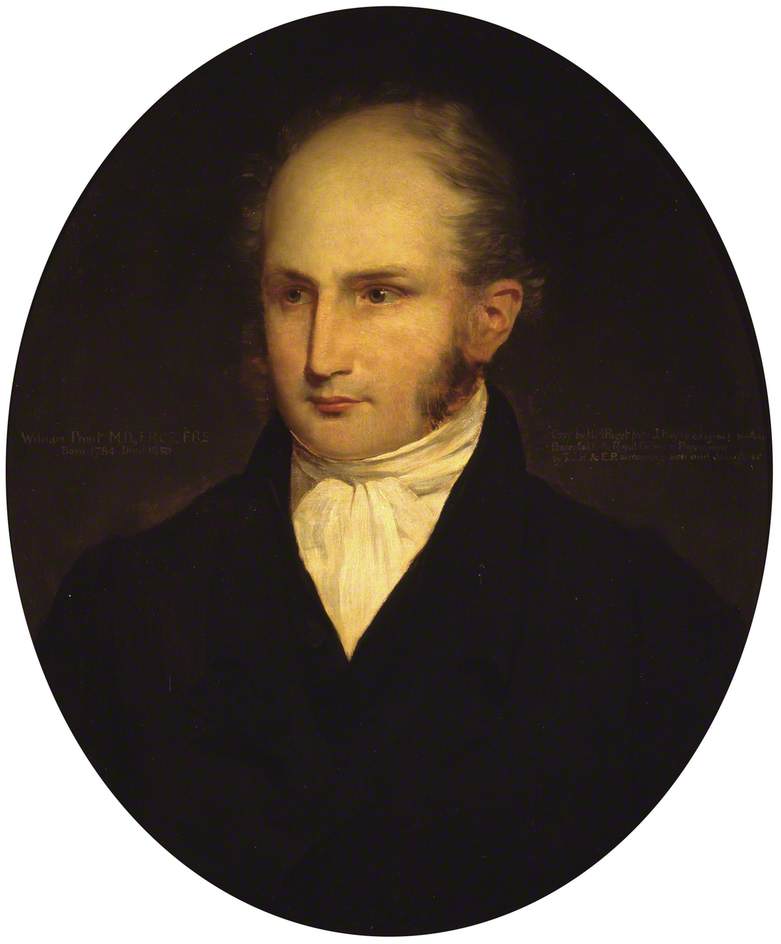William Prout (1785–1850): a multifaceted chemist and physician
Prout’s personal and professional history makes us known as a scholar who has made important contributions in many fields of knowledge, from chemistry to physiology and medicine. In this article we will deal with two aspects of his research both derived from his early work on the relationship between density and atomic weights of gases that he was among the first to set up. The first is the conception of the structure of the atom, the second is the idea of the diatomicity of the molecules of elementary gases.
 William Prout and the unitary hypothesis
William Prout and the unitary hypothesis
William Prout (1785 – 1850) was a chemist and physician who is known for his unitary hypothesis, which is that the atoms of all elements are made up of a set of hydrogen atoms. This conception of atoms is hardly mentioned in school textbooks, despite the fact that he has conditioned the history of chemistry for over a century, obtaining both a strong consensus and an equally rejection by the community of chemists and physicists. Precisely because of the consequences that this hypothesis contained in itself, he had the merit of stimulating the research that led to the unveiling of the structure of atoms. At the end of his journey, he showed that he had a foundation: the mass of atoms is determined by protons and neutrons, particles with a mass equivalent to that of a hydrogen atom.
The first PDF attached tells the story of this unitary hypothesis
William Prout as Amedeo Avogadro
The medical Prout, whose research and discoveries are another aspect of his quality as a scientist, will not be addressed in this article. Another face of this multifaceted scientist will be highlighted, which is completely neglected. It concerns his intuitions on the conception of diatomic molecules of elementary gases in relation to the determination of atomic weights. With great surprise we see that he autonomously conceived what is called “Avogadro’s principle but he posed it in a surprisingly clear way.
The second attached PDF develops this part



2 commenti
Dear Roberto,
the story of Prout´s hypothesis is not complete as long as you do not talk about the work of Edward Williams Morley and his determination of the atomic weight of oxygen as 15,879 (+-0,00032) for atomic weight of hydrogen taken as 1, which directly gives the atomic weight of hydrogen as 1,0076 for atomic weight of oxygen taken as 16. For the contemporaries of Morley, this was the direct and undoubtfully the ultimate, because chemically convincing falsification of Prout´s hypothesis. Edward W. Morley published the results of his 12 year enduring experimental campaign in 1895 and he earned highest esteems among the scientific community in the US and in Europe. But somehow, after 1897, his discovery was more and more neglected, as the chemists of the time went on to use the convention of oxygen as the atomic weight standard taken as 16, without further discussing the atomistic implications of the mean relative atomic mass of oxygen proven to be 15,879. When Theodore W. Richards got the Nobel prize for 1914, he mentioned Edward W. Morley with only one sentence but could not admit that he failed to reach the necessary accuracy and never came even close to the reliability of Morleys work.
After WWI, the research on isotopes, atomic weights and radioactivity got dominated by physicists and then, somehow the memory of the scientific community concerning Edward W. Morley began to fade out. Up to our days, Edward W. Morley and his value for oxygens atomic weight being 15,879 didn´t make it into the chemistry textbooks, at least as far that I am aware of. That´s why I would be much interested to learn more about the late history of Prout´s hypothesis. As a chemist, I am not at all fond of this vague manner of speaking about Prout´s hypothesis as some sort of driver for atom physics or isotope research. The falsification of Prout´s hypothesis, by the way, was confirmed by the discovery of oxygen isotopes 17-O and 18-O by William F. Giauque and Herrick L. Johnston, in 1929. They were chemists, working to get a grip on low temperature experimentation and therefore, Giauque was in need of a reliable value for the entropy of oxygen. So he applied statistical thermodynamics theory onto the band spectra of naturally occurring oxygen in the atmosphere and found out that the rotational-vibrational transitions found in those band spectra were incompatible with just one 16-O isotope. That was the moment, when Prout´s hypothesis was found dead a second time. With these results, it is immediately evident that you can´t have an integer value for the mean relative atomic mass (“atomic weight”) of naturally occurring oxygen, becuase the linear combination of any integer higher than 16 will never result in the physicochemcally observable value 15,879. But, once again, not one single mention in the textbooks. So my question is – do you know something about the late history of Prout´s hypothesis? If so, I would be eager to hearig from you.
Best regards
Marcus Wolf
Dear Marcus
I have read with great interest the information you gave me about Prout’s hypothesis at the turn of the 20th century, through the history of Morley, Richards, Giauque and Johnston. My research on Prout’s hypothesis had stopped earlier. Your information projects forward from the time I had chosen. So with regret I have to tell you that I have no further elements to add to yours. Thanks for your updates.